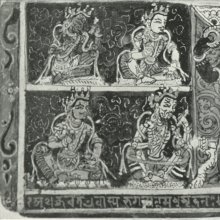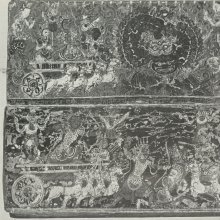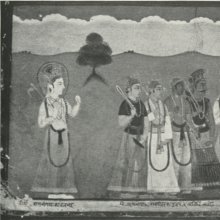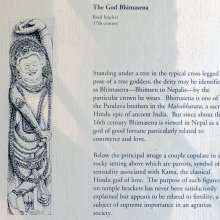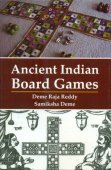Mahabharata, Maha-bharata, Mahābhārata: 16 definitions
Introduction:
Mahabharata means something in Hinduism, Sanskrit, the history of ancient India, Marathi. If you want to know the exact meaning, history, etymology or English translation of this term then check out the descriptions on this page. Add your comment or reference to a book if you want to contribute to this summary article.
Images (photo gallery)
In Hinduism
Vaishnavism (Vaishava dharma)
Source: ISKCON Press: GlossaryMahābhārata (महाभारत).—An important and famous itihāsa (historical) scripture belonging to the smṛti section of the Vedic scriptures. The Mahābhārata narrates the history of the great Kuru dynasty of kṣatriyas (warriors) that was annihilated by the Kurukṣetra war. Contained within the Mahā-bhārata is the Bhagavad-gītā.
Source: Pure Bhakti: Bhagavad-gita (4th edition)Mahābhārata (महाभारत) refers to “epic describing the ancient history of the world leading up to the battle of Kurukṣetra. It was composed by Śrīla Kṛṣṇa Dvaipāyana Vyāsadeva for the benefit of the people of this age of Kali, who have no interest in philosophy. Śrīmad Bhagavad-gītā is strategically placed in the midst of this epic”. (cf. Glossary page from Śrīmad-Bhagavad-Gītā).

Vaishnava (वैष्णव, vaiṣṇava) or vaishnavism (vaiṣṇavism) represents a tradition of Hinduism worshipping Vishnu as the supreme Lord. Similar to the Shaktism and Shaivism traditions, Vaishnavism also developed as an individual movement, famous for its exposition of the dashavatara (‘ten avatars of Vishnu’).
Purana and Itihasa (epic history)
Source: Cologne Digital Sanskrit Dictionaries: The Purana IndexMahābhārata (महाभारत).—Compiled by Vyāsa Kṛṣṇadvaipāyana;1 the moon of, arose from Vyāsa.2

The Purana (पुराण, purāṇas) refers to Sanskrit literature preserving ancient India’s vast cultural history, including historical legends, religious ceremonies, various arts and sciences. The eighteen mahapuranas total over 400,000 shlokas (metrical couplets) and date to at least several centuries BCE.
Dhanurveda (science of warfare)
Source: Knowledge Traditions & Practices of India: Martial Arts Traditions: A SurveyMahābhārata (महाभारत) is the name of a Sanskrit text partly dealing with the ancient Indian science of martial arts (dhanurveda).— Sections of the Mahābhārata describe wrestlers and wrestling and boxing bouts, such as Bhīma’s famous fights with Jarāsaṃdha and with Duryodhana.
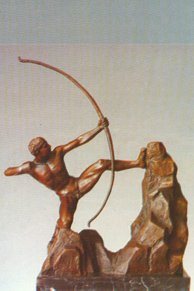
Dhanurveda (धनुर्वेद) refers to the “knowledge of warfare” and, as an upaveda, is associated with the Ṛgveda. It contains instructions on warfare, archery and ancient Indian martial arts, dating back to the 2nd-3rd millennium BCE.
General definition (in Hinduism)
Source: Wisdom Library: HinduismMahābhārata (महाभारत) is the longest Indian epic poem in Hindu literature which also has a lot of philosophical connotation. Mahabharata means “The great narrative of the battle of the Bharatas”. The Bharatas, as mentioned in the Rig Veda, lived in the country of the Upper Granges and the Yamuna River. According to Hindu mythology it is believed that Mahabharata was written by Veda Vyasa. The main action of Mahabharata revolves around the contest of Pandavas and Kauravas and the contest is set in the strategic and fertile plain of Delhi. The Kauravas were the hundred sons of Dhritarashtra and their capital was Hastinapur, the Pandavas on the other hand were the five sons of Pandu.
India history and geography
Source: academia.edu: Who were the HunasThe Mahabharata text, ancient tradition and epigraphic evidence unambiguously suggest that the date of Mahabharata war and the epoch of Yudhishthira era to be around 3162 BCE or 3163 BC. Mahabharata text and Aryabhata clearly inform us that the epoch of Kaliyuga commenced before Mahabharata war

The history of India traces the identification of countries, villages, towns and other regions of India, as well as mythology, zoology, royal dynasties, rulers, tribes, local festivities and traditions and regional languages. Ancient India enjoyed religious freedom and encourages the path of Dharma, a concept common to Buddhism, Hinduism, and Jainism.
Languages of India and abroad
Marathi-English dictionary
Source: DDSA: The Molesworth Marathi and English Dictionarymahābhārata (महाभारत).—n (S) The great sacred epic poem of the Hindus, narrating the war which occurred amongst the descendants of bharata, the younger brother of rāma.
Source: DDSA: The Aryabhusan school dictionary, Marathi-Englishmahābhārata (महाभारत).—n The great sacred epic poem of the Hindus.
Marathi is an Indo-European language having over 70 million native speakers people in (predominantly) Maharashtra India. Marathi, like many other Indo-Aryan languages, evolved from early forms of Prakrit, which itself is a subset of Sanskrit, one of the most ancient languages of the world.
Sanskrit dictionary
Source: DDSA: The practical Sanskrit-English dictionaryMahābhārata (महाभारत).—Name of the celebrated epic which describes the rivalries and contests of the sons of Dhṛtarāṣṭra and Pāṇḍu. (It consists of 18 Parvans or books, and is said to be the composition of Vyāsa; cf. the word bhārata also); महत्त्वाद्भारतत्वाच्च महाभारतमुच्यते (mahattvādbhāratatvācca mahābhāratamucyate)
Derivable forms: mahābhāratam (महाभारतम्).
Mahābhārata is a Sanskrit compound consisting of the terms mahā and bhārata (भारत).
Source: Cologne Digital Sanskrit Dictionaries: Shabda-Sagara Sanskrit-English DictionaryMahābhārata (महाभारत).—n.
(-taṃ) Name of the great epic which details the history of the sons of Dhritarastra and Pandu.
Source: Cologne Digital Sanskrit Dictionaries: Cappeller Sanskrit-English DictionaryMahābhārata (महाभारत).—[substantive] (±āhava or yuddha) the great war of the Bharatas; [neuter] (±ākhyāna) the great narrative of the war of the Bh.
Source: Cologne Digital Sanskrit Dictionaries: Aufrecht Catalogus Catalogorum1) Mahābhārata (महाभारत) as mentioned in Aufrecht’s Catalogus Catalogorum:—1) In the case of Poona. and Oppert. the parvans or parts of parvans have noot been marked. Jones. 401. 402. [Mackenzie Collection] 57. Cop. 99 (Virāṭaparvan). Io. 378. 465. 468. 497 -514. 546-48. W. p. 103-8. Oxf. 1. 2. 358^a ([fragmentary]). Bodl. 18 (Udyogaparvan and—[commentary] by Nīlakaṇṭha). Paris. (B 20. 213-20). Khn. 24 (and—[commentary]). B. 2, 60. 62. 64. Report. Xi. Ben. 57-63. Tu7b. 23 (Vanaparvan). Haug. 46 (Dānadharma and—[commentary]). Bik. 172 -182. Kāṭm. 1 (and—[commentary]). Pheh. 15 (Udyogaparvan). Rādh. 40 (and—[commentary]). Np. Iv, 8-22. 36, etc. Burnell. 180^a. Gu. 4 (Ādiparvan). Bh. 10-16. Bhr. 56 -67. 565. 566. Poona. 353-56. 359. 376-78. 381. 388. 468-540. 570. 614. 615. 617. 620. 630. 633. 662. Ii, 4. 11. 16. 17. 23. 34. 38. 86. 112-14. 130-40. 144. 161-68. 191-200. 221. 231. 266 -78. 280. 282-88. Jac. 697 (Virāṭaparvan). Taylor. 1, 60. 64. 167. Oppert. 5. 307. 583. 911. 1086. 1394. 1573. 1943. 2131. 2154. 2173. 2248. 2562. 2566. 2650. 2765. 2769. 2781. 2856. 2936. 2982. 3008. 3032. 3085. 3437. 3584. 3585. 3663. 3824. 4122. 4233. 4429. 4757. 4773. 4998. 5111. 5117. 5283. 5447. 5503. 5848. 5860. 5890. 6001. 6092. 6099. 6142. 6265. 6309. 6445. 6624. 6963. 7269-72. 7275. 7320. 7417. 7442. 7451. 7619. 8145. Ii, 21. 26. 29. 31. 34. 49. 52. 70. 126. 181. 201. 251. 261. 267. 268. 290. 303. 304. 307. 835. 965. 1371. 1419. 1506. 1536. 1677. 1788. 2138. 2233-36. 2252. 2272. 2302. 2457. 2490. 2506. 2507. 2531. 2538. 2556. 2570. 2577. 2610. 2789. 2845. 3038. 3041. 3043. 3044. 3072. 3079. 3228. 3453. 3458. 3464. 3465. 3481-83. 3532. 3540. 3549. 3668. 4257. 4258. 4261. 4263. 4269. 4273. 4281. 4304. 4336. 4342. 4346. 4353. 4362. 4373. 4834. 4987. 5551. 5726. 5727. 5731. 5763. 5802. 5867. 5981. 6029. 6200. 6203. 6211. 6222. 6223. 6251. 6364. 6372. 6430. 6466. 6490. 6516. 6683. 6734. 6770. 6800. 6818. 6828. 7125. 7172. 7175. 7489. 7490. 7493. 7497. 7505. 7514. 7595. 7678. 7750. 7788. 7826. 7967. 8511. 8518. 8616. 8619. 8625. 8626. 8635. 8648. 8671. 8679. 8688. 8757. 8818. 8824. 8911. 8946. 9074. 9640. 9736. 9738. 9789. 10289. 10359. Rice. 64. 66. Bp. 293 (Mokṣadharma). W. 1510-22. Proceed. Asb. 1869, 224 (Virāṭa- parvan). Verses from it are given by Kṣemendra. Śp. p. 88. [Sūktikarṇāmṛta by Śrīdharadāsa] [Subhāshitāvali by Vallabhadeva] Padyāvalī.
—[commentary] Oppert. 2676. 2764. 2967. 5905. 6143. 6144. 6203. 7365. Ii, 27. 331. 351.
—[commentary] Mahābhāratatilaka. Oppert. Ii, 4794.
—[commentary] Mahābhāratanirvacana. Oppert. 6961.
—[commentary] Yakṣapraśna. Oppert. 7366.
—[commentary] Lakṣāvatāra. Oppert. 2932.
—[commentary] Bhāratārthadīpikā by Arjunamiśra. W. p. 104 -6. Oxf. 2^b. L. 2126. 2158. B. 2, 62. 64. Bh. 13. 15. Poona. 476. 483. 485.
—[commentary] Vyākhyāratnāvalī by Ānandapūrṇa Muni Vidyāsāgara. Burnell. 184. Bh. 15.
—[commentary] Vākyadīpikā by Caturbhuja Miśra. W. p. 104. 105. Bh. 13.
—[commentary] Jñānadīpikā by Devabodha. W. p. 105. L. 527. 3009. 3010. Bh. 13.
—[commentary] Gūḍhārthaprakāśikā by Nandakiśora. Sūcīpattra. 67.
—[commentary] by Nandanācārya. Burnell. 184^b (Mokṣadharma).
—[commentary] Bhāratārthaprakāśa by Nārāyaṇa Sarvajña. W. p. 105. 107. Oxf. 2^a. Burnell. 184^a. Bh. 13.
—[commentary] Bhāratabhāvadīpa by Nīlakaṇṭha Cāturdhara. Jones. 401. 402. Io. 378. 465. 468. 546-48. W. p. 106-8. 110. Oxf. 1. 2. L. 1199. B. 2, 62. Ben. 57-61. Np. Iv, 8-22. 36, etc. Bh. 10-12. Poona. 441. 477. 479. 486-91. 495. 496. 505-8. 511. 512. 519. 523-25. 538. 539. 620. 623. Ii, 34. 140. 163-68. 195. 221. 266. 270-78. 282-88. Oppert. Ii, 4335. 6786. W. 1510-22.
—[commentary] by Paramānanda Bhaṭṭācārya. Burnell. 184^a (Mokṣadharma).
—[commentary] by Yajñanārāyaṇa. [Mackenzie Collection] 60. Burnell. 184^b. Oppert. Ii, 4835.
—[commentary] by Ratnagarbha. B. 2, 64.
—[commentary] Prakāśinī or Virodhabhañjinī by Rāmakṛṣṇa. L. 2084-96. Burnell. 184^a.
—[commentary] by Lakṣmaṇabhaṭṭa. Burnell. 184^a.
—[commentary] Durbodhapadabhañjinī by Vimalabodha. L. 3011. B. 2, 64. Ben. 63. Burnell. 184^a.
—[commentary] by Vaiśampāyana. Burnell. 184^a. He quotes Devasvāmin.
—[commentary] by Śrīnivāsācārya. Burnell. 184^a. Mahābhārate Gaṅgāmāhātmya. H. 30.
—Nalopākhyāna q. v.
—Bhīṣmastavarāja q. v.
—Viṣṇusahasranāman q. v.
—Śivastotra. Burnell. 202^a. Bp. 294.
—Sāvitrī. Paris. (B 95 b). Taylor. 1, 356. Oppert. 3664. 4431. Peters. 1, 117.
—Somavatīkathā. Ben. 53.
—Hariścandropākhyāna. Oppert. Ii, 2540. 9866.
Mahābhārata has the following synonyms: Bhārata.
2) Mahābhārata (महाभारत):—abridged by Caturbhujamiśra. Io. 470-72.
3) Mahābhārata (महाभारत):—Cu. Nn. 3. Cu. add. 2106 (Sabhāparvan). 1540 (Udyogap.). 1542 (Virāṭap.). 1624 (Droṇap.). Fl. 421 (Sabhāp.). 422 Udyogap.). Gov. Or. Libr. Madras 66. Hz. 128 (Droṇa and Udyoga). Io. 184. 378. 465. 468. 497-514. 546-48. 1907 (Ādip. with
—[commentary] by Arjunamiśra, Sabhāp. with
—[commentary] by Devabodha). 1908 (Vanap. with
—[commentary] by Caturbhuja). 1909 (Virāṭap. with
—[commentary] by Caturbhuja, Udyogap. with
—[commentary] by Nārāyaṇa Sarvajña). 1910 (Bhīṣmap. with
—[commentary] by Arjunamiśra). 1911 (Droṇap. and Karṇap. with a
—[commentary]). 1912 (Gadāp., Aiṣīkap., Viśokap., Strīp., Rājap., Āpaddharma and—[commentary]). 1913 (Mokṣap. with
—[commentary] by Arjunamiśra), 1914 (Dānap. and Āśvamedhikap. with a
—[commentary] Mausalap., Āśramavāsikap., Sauptikap. with a
—[commentary], Mahāprasthānikap., Svargārohaṇikap. with
—[commentary] by Nārāyaṇa Sarvajña). 2137 (Ādip., Virāṭap., Bhīṣmap., and [fragmentary] of Dānap.). 2452-53 (Mokṣap. and Dānap.). 2744-51. 2767 (Udyogap.). 2768 (Vanap. inc.). 3130-39. 3155. 3156. 3239 (Ādip. [fragmentary]). Lund I (Bhīṣmap.). Oudh. Xx, 20. 28. Xxi, 34. Peters. 4, 14 (Svargārohaṇa). Rgb. 112-17 (Vanap., Udyogap., Dānadharma). 167-70 (Sabhāp., Udyogap., Bhīṣmap., Droṇap.). Stein 196.
—[commentary] Kūṭavyākhyā. Rgb. 171 (inc.).
—[commentary] Bhāratapadaprakāśa. Quoted by Hemādri in Dānakhaṇḍa p. 448.
—[commentary] Bhāratārthadīpikā by Arjunamiśra. Rgb. 169 (Bhīṣmap.). Stein 196 (Dānadharma).
—[commentary] Vyākhyāratnāvalī by Ānandapūrṇa Muni. [Bhau Dāji Memorial] 93. Gov. Or. Libr. Madras 67 (Śāntip.).
—[commentary] by Kuravirāma. Mentioned by him in his Viśvaguṇādarśaṭīkā, Hz. Extr. 57.
—[commentary] Vākyadīpikā by Caturbhuja. Rgb. 170 (Droṇap.).
—[commentary] Jñānadīpikā by Devabodha. Oudh. Xx, 30. Xxii, 56. Rgb. 167. 168 (Sabhāp., Udyogap.).
—[commentary] Bhāratabhāvadīpa by Nīlakaṇṭha. Cu. Nn. 3. Gov. Or. Libr. Madras 66. 67. Io. 378. 465. 468. 546-48. 2744-51. 3130-39. 3155. 3156. Oudh. Xx, 28. Stein 196.
—[commentary] Viṣamaślokaṭīkā by Rāmakiṃkara Nyāyālaṃkāra. Io. 1411.
—[commentary] Mahābhāratasaṃkṣepaṭīkā or Vyākhyāpradīpa by Rāmānuja. Io. 470.
—[commentary] by Śrīnivāsa. Hz. 240 (Sabhā). Mahābhārate Tīrthayātrā of Vanaparvan, with
—[commentary] by Nīlakaṇṭha. Io. 2569.
—Naranārāyaṇīya. Fl. 10.
4) Mahābhārata (महाभारत):—Ulwar 849.
—[commentary] by Nīlakaṇṭha, son of Govinda. Ulwar 850.
5) Mahābhārata (महाभारत):—Bc 399-401. Ed. U. (13 Volumes). On a long scroll Ed. U. Tod 77 (8 Voll. Mahābhārata and Harivaṃśa). Ādiparvan. Ak 182. As p. 139. Bc 459. 501. Bd. 209. Cr. (inc.). Cs 4, 112. 121. 123 (inc.). 133. 157 (inc.). 160. Whish 65 (Paulomaparvan and Āstīkaparvan of the Ādiparvan).
—Sabhā. As p. 140. Bd. 210. Cs 4, 110 (inc.). 113. 121. 132 ([fragmentary]). 133. 145 (inc.). 161 (inc.). Whish 18.
—Vana. Ak 183. 184. As p. 140. Bc 310. Bd. 168. 211 (inc.). Cs 4, 110 (inc.). 115. 124 (and C.). 132. 133. 162. Il (chapters 50-76). Tb. 38. Whish 62.
—Virāṭa. Ak 187. As p. 140 (2 Mss.). Bc 194. Bd. 212 (inc.). Cr. Cs 4, 110. 111 (inc.). 115. 125. 128 (inc.). 133. 134 (and C.). 146. 155 (inc.). 163. 166 (inc.). L.. 133. 141. Whish 53. Thomas App. p. 256 (as far as 12, 7).
—Udyoga. Ak 185. As p. 140. Cs 4, 110. 115. 121. 135 (and C.). 147. 152 (inc.). 156 (and C. inc.). 165. Hz. 795. L.. 134 (till 175, 42). Whish 84 A (1-94). 84 B (41-198).
—Bhīṣma. Ak 188. As p. 140. Bd. 213. Cs 4, 110. 127. 136. 147 (inc.). 164. Hz. 795.
—Droṇa. Ak 189. As p. 139. Bc 193. Cs 4, 110. 116. 126. 127. 131. 138 (inc.). 141. 142. 144 (inc.). 146. 159. Hz. 795. Whish 86 (1-34).
—Karṇa. Ak 190. 191. 192 (inc.). As p. 140. Bd. 214 (inc.). Cs 4, 110. 114. 126. 131. 137. 141. 167. Tb. 40.
—Śalya. Ak 193 (and Gadā). As p. 140 (2 Mss.). Bc 194. Bd. 215. Cs 4, 110. 119. 126. 137. 167 (all 4 with Gadā). 308. L.. 135. Gadā Bd. 216. Cs 4, 308. L.. 140. Tb. 41.-Sauptika. Ak 194. As p. 140. Bc 194. Bd. 217. Cs 4, 119. 126. 137. 148. 167. 308. Aiṣīka. Ak 195. Bc 194. Bd. 170. L.. 136. Viśoka. Cs 4, 148.
—Strī. Ak 196. 197. As p. 140. Bc 194. Bd. 218. Cs 4, 110. 119. 126. 137. 148. 167. 171. 308.
—Śānti. Ak 198. Bd. 169. Cs 4, 110. 130. 131. 148 (inc.). Tb. 42. Rājadharma. As p. 139. Bd. 219. Cs 4, 120 (and C.). 148 ([fragmentary]). 168. Tb. 42. Āpaddharma. Bd. 220. Cs 4, 151. Mokṣadharma. Ak 200. As p. 140. Bd. 221. Cs 4, 120 (and C.). 150. 168.
—Anuśāsana. Ak 201. 202. Bd. 222. Cr. Cs 4, 129 (inc.). Tb. 43. Dānadharma. Ak 199. As p. 139. Cs 4, 117. 118. 139 (and C. inc.). 149. 168. 169. L.. 142. Rep. p. 5.
—Aśvamedha. Ak 203. As p. 139. Bd. 223. 228 (Dharmayajña). Cs 4, 122. 129 (and C. inc.). 131. 140 (and C.). 153. 170. L.. 143. Whish 51.
—Āśramavāsa. Ak 204. As p. 139. Bd. 224. Cs 4, 110. 122. 129. 131. 172. Whish 51.
—Mausala. Ak 205. 206. As p. 139. 140 (and C.). Bd. 225. Cs 4, 122. 129. 131. 140. 173. Whish 51.
—Mahāprasthāna. As p. 139. Bd. 226. Cs 4, 110. 122. 129. 131. 140. 173. Whish 51.-Svargārohaṇa. Ak 207. Bd. 227. Cs 4. 122. 131. 158 (inc.). 173. Whish 51. C. Mahābhāratārthapradīpikā by Arjunamiśra. Cs 4, 269 (complete). Ādiparvan. Cs 4, 413. Vana. Cs 4, 310. Sabhā. Cs 4, 312. Udyoga. Cs 4, 311. Mokṣadharma. Hpr. 1, 295. An Epitome from his C. on the Vanaparvan. Tb. 39. C. Vyākhyāratnāvalī by Ānandapūrṇa Vidyāsāgara. Mokṣadharma. As p. 153. Cs 4, 168. Rājadharma. Cs 4, 168. Dānadharma. Cs 4, 168. C. by Caturdhara. Aiṣīka. Ak 195. C. by Nārāyaṇa Sarvajña. Anukramaṇikādhyāya only. Ak 180. C. Bhāratabhāvadīpa by Nīlakaṇṭha. Bc 399 -401 (on the whole Mahābhārata). Ed. U. (on the whole). Ādiparvan. Bc 281. Cs 4, 160. Sabhā. Cs 4, 161 (inc.). Vana. Cs 4, 162. Virāṭa. Bd. 212. Cs 4, 115. 163. Udyoga. Cs 4, 115. 165. Bhīṣma. Cs 4, 164. Karṇa. Bd. 214. Strī. Cs 4, 171. Anuśāsana. Bd. 222. Cr. Tb. 43. Dānadharma. Cs 4, 117. 169. Aśvamedha. Cs 170. C. Bhāvārthaprakāśikā by Rāmakṛṣṇa. Virāṭaparvan. Hpr. 1, 334. C. Durbodhapadabhañjikā by Vimalabodha. Bd. 167. Cs 4, 175. Hz. 1220 (inc.).
1) Mahābhārata (महाभारत):—[=mahā-bhārata] [from mahā > mah] m. or n. (with or [scilicet] āhava, yuddha or any word signifying ‘battle’) the gr° war of the Bharatas, [Mahābhārata; Harivaṃśa]
2) [v.s. ...] n. (with or [scilicet] ākhyāna), ‘great narrative of the war of the Bh°s’, Name of the gr° epic poem in about 215, 000 lines describing the acts and contests of the sons of the two brothers Dhṛtarāṣṭra and Pāṇḍu, descendants of Bharata, who were of the lunar line of kings reigning in the neighbourhood of Hastinā-pura (the poem consists of 18 books with a supplement called Hari-vaṃśa, the whole being attributed to the sage Vyāsa), [Āśvalāyana-gṛhya-sūtra; Mahābhārata] etc. ([Indian Wisdom, by Sir M. Monier-Williams 370 etc.])
[Sanskrit to German]
Sanskrit, also spelled संस्कृतम् (saṃskṛtam), is an ancient language of India commonly seen as the grandmother of the Indo-European language family (even English!). Closely allied with Prakrit and Pali, Sanskrit is more exhaustive in both grammar and terms and has the most extensive collection of literature in the world, greatly surpassing its sister-languages Greek and Latin.
Kannada-English dictionary
Source: Alar: Kannada-English corpusMahābhārata (ಮಹಾಭಾರತ):—[noun] one of the two great epics of India written in Saṃskřta, dealing mainly with the conflict between the Pāndavas and the Kauravas, which includes the Bhagavad-Gita.
Kannada is a Dravidian language (as opposed to the Indo-European language family) mainly spoken in the southwestern region of India.
See also (Relevant definitions)
Partial matches: Maha, Bharata.
Starts with (+17): Mahabharata-tatparya-nirnaya-vyakhya, Mahabharata-tatparya-nirnayanukramanika, Mahabharata-vritti, Mahabharatadarpana, Mahabharatadhyayanukramani, Mahabharatadishloka, Mahabharatagartoddhara, Mahabharatakathanaka, Mahabharatakutoddara, Mahabharatakutoddhara, Mahabharatamanjari, Mahabharatamimamsa, Mahabharatapancaratna, Mahabharatapancaratnani, Mahabharataparvanukirtana, Mahabharatasamgraha, Mahabharatasamgrahadipika, Mahabharatasamuccaya, Mahabharatasaptatishloka, Mahabharatasara.
Full-text (+27390): Vaishampayana, Yamakabharata, Uttamaujas, Mahabharatamanjari, Mahabharatakutoddara, Mahabharatatatparya, Mahabharatashlokopanyasa, Mahabharatasara, Mahabharatasuci, Shantiparvan, Mahabharatasamuccaya, Mahabharatamimamsa, Mahabharatadarpana, Mahabharatavyakhyana, Mahabharatasamgraha, Mahabharatatatparyaraksha, Mahabharatasarasamgraha, Mahabharatavivaranastotra, Mahabharatatatparyasamgraha, Mahabharatashravanavidhi.
Relevant text
Search found 211 books and stories containing Mahabharata, Maha-bharata, Mahābhārata, Mahā-bhārata; (plurals include: Mahabharatas, bharatas, Mahābhāratas, bhāratas). You can also click to the full overview containing English textual excerpts. Below are direct links for the most relevant articles:
Narayaniya (Narayaneeyam) (by Vishwa Adluri)
Puranic encyclopaedia (by Vettam Mani)
Brahma Sutras (Nimbarka commentary) (by Roma Bose)
Brahma-Sūtra 3.1.19 (correct conclusion, continued) < [Adhikaraṇa 3 - Sūtras 12-21]
Brahma-Sūtra 4.2.13 < [Adhikaraṇa 5 - Sūtras 7-13]
Brahma-Sūtra 2.1.18 < [Adhikaraṇa 6 - Sūtras 14-19]
Lord Hayagriva in Sanskrit Literature (by Anindita Adhikari)
Chronological Development (3): Udyoga Parva < [Chapter 3]
Central Myth (6): Birth of Madhu-Kaiṭabha < [Chapter 3]
Hayagrīva in the Mahābhārata (Introduction) < [Chapter 3]
A History of Indian Philosophy Volume 2 (by Surendranath Dasgupta)
Part 12 - Bhāgavata and the Bhagavad-gita < [Chapter XIV - The Philosophy of the Bhagavad-gītā]
Part 12 - Viṣṇu, Vasudeva and Kṛṣṇa < [Chapter XIV - The Philosophy of the Bhagavad-gītā]
Part 3 - Sāṃkhya and Yoga in the Gītā < [Chapter XIV - The Philosophy of the Bhagavad-gītā]
The Markandeya Purana (by Frederick Eden Pargiter)
Related products
(+3 more products available)
